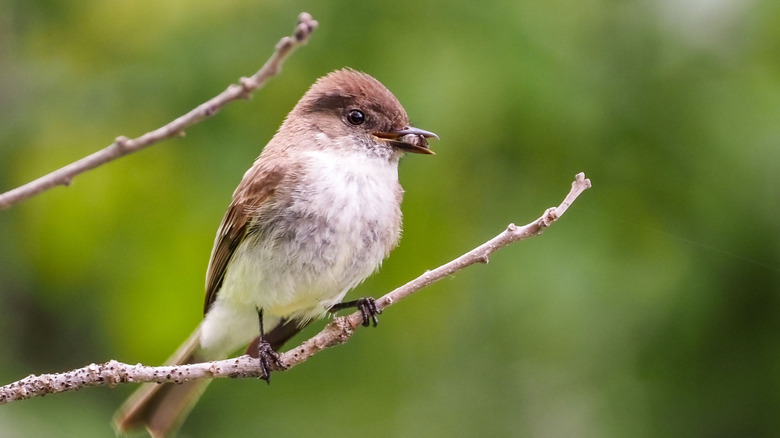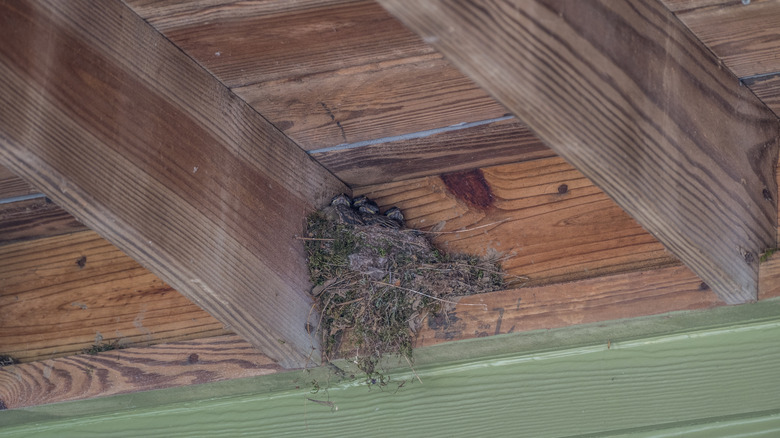The Insect-Eating Bird You'll Want To Attract To Your Garden
Looking for a natural way to keep your garden free of pesky insects? There are many eco-friendly ways to keep bugs out of your garden, but attracting feathered friends could be one of the most entertaining options. Birds famously munch away on a variety of insects, making them ideal candidates for protecting your garden. Plus, you get a good show as they enjoy your yard. Phoebes are particularly adept at swooping in and dining on some of the peskiest varieties, including flies and mosquitoes. That makes sense considering they belong to the flycatcher family of birds. Phoebes are, however, a little trickier to attract than some birds — your typical bird feeders and birdhouses won't do the trick. Adding a water feature and nesting shelves could make your yard more appealing, though.
You could attract one of three types of phoebes, depending on where you live. Say's phoebes are found primarily in the Western U.S., with a range from Alaska to Mexico, depending on the time of the year. You'll typically find this brown bird with an orange belly in dry areas, including deserts and tundras. Black phoebes live in the Southwest and Mexico year-round. They often live along bodies of water like creeks and ponds. Meanwhile, the Eastern phoebe inhabits the eastern half of North America, often preferring farms and wooded areas. They also visit suburban areas, particularly quiet, wooded lots. No matter where you live, attracting phoebes to your yard could help keep the population of flies, mosquitoes, moths, and other insects under control.
Install nesting structures under your eaves to attract phoebes
Phoebes build nests from mud and grass, which they usually place in a protected area, such as under a bridge or the overhang of your eaves. These insect-eating birds won't find a typical birdhouse for your yard appealing, but they may use a nesting shelf as the foundation for their homes. When you install your nesting structure before the breeding season begins, you may encourage a breeding pair of phoebes to make your backyard their home. These insect-eating birds will reuse nests, so you don't have to clear out your shelves from year to year.
Installing the nesting structure under the eaves of your house is often effective, since phoebes sometimes build their nests on structures anyway. Positioning the structure as close to the eave as possible could make it more attractive. Place the nesting shelf away from doors and outdoor entertaining areas that tend to be busy.
If you're trying to attract Eastern phoebes, install the nesting structure between 3 and 16 feet off the ground in an area near fresh water, if possible. Leave about 165 feet between nesting structures. Say's phoebes are more challenging to attract with nesting shelves, so make your structures as appealing as possible by placing them close to a light fixture or other prime source of insects. The ideal height for a nesting structure for Say's phoebes is 4 to 9 feet off the ground. Leave 330 feet between nesting structures for this species.
Phoebes also like water features and native plants
As flycatchers, phoebes typically grab insects out of the air when they're hungry. They often fly over water to catch bugs, which is why adding a small pond or water feature to your yard could help attract these mosquito-eating birds. Eastern phoebes in particular appreciate a source of fresh water nearby. If you don't want to build an in-ground water feature, setting up a birdbath still offers easy access to clean water. Phoebes also need mud to build their nests, so allowing a muddy area to form in your yard may help.
Native plants may also help make your yard attractive for phoebes because they invite biodiversity, which allows the birds to forage. It also helps create a more natural environment for phoebes. These birds often sit on branches waiting for bugs to fly by. Shrubs and other plants with low branches offer them ideal perching spots for their insect-hunting activities. Eastern phoebes will also eat the berries from sumac and elderberry, so planting them in your yard offers another source of food.


